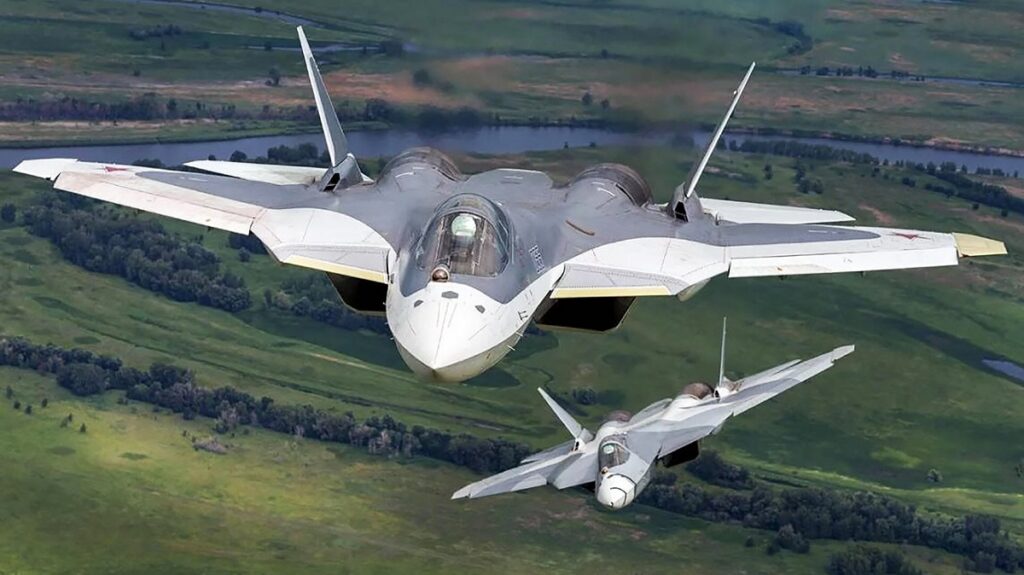Sukhoi claims Su-57 has an RCS goal between 0.1 to 1 m^2 (-10 to 1 dBsm). For comparison, the F-117 had an RCS of around -25 dBsm while the F-22 and F-35 have an RCS better than -40 dBsm – which is at least 1,000 to 10,000 times smaller than the Su-57
The Sukhoi Su-57 Felon’s configuration is a development of the Su-27’s design modified for low visibility, supersonic speed, and agility.
According to Piotr Butowski’s explanation in Russia’s Warplanes, Volume 1, internal weapon carriage is the primary way to decrease radar visibility. Installed in the engine air intake ducts, radar blockers lessen reflections from the engine inlet guiding vanes. In order to minimize the number of directions in which electromagnetic waves are reflected and to guarantee that these directions are the safest, the airframe’s shape has been chosen.
The equipment of the fighter is the subject of another group of stealth measures. The radiation from the enemy’s radar is diverted away by the NO36 radar arrays’ surfaces being deflected from the vertical plane. The arrays’ domes are selective; while allowing their own signal to get through, they block other frequencies. Additionally, to absorb “freak waves,” which happen when a wave is amplified after several reflections within an enclosed space, the compartments for these arrays have coatings on their edges that are radar-absorbent.
Multiple systems, such as the radar, ECM, and IFF systems, employ the available arrays simultaneously to lower their total number. Antennas that do not extend beyond the airframe outlines are used within the antenna-feeder system, and the vertical empennage serves as an antenna for the communications suite. When in cruise configuration, the 101KS-V IRST’s turret is turned backward and has a coating on its rear hemisphere to absorb radar waves.

The US-made F-22 Raptor and F-35 Lightning II are not comparable to the Su-57, despite the latter being touted as a fifth-generation fighter. The Felon, on the other hand, is not a real stealth fighter. Why?
‘Sukhoi claims Su-57 has an RCS goal between 0.1 to 1 m^2 (-10 to 1 dBsm). For comparison, the F-117 had an RCS of around -25 dBsm while the F-22 and F-35 have an RCS better than -40 dBsm – which is at least 1,000 to 10,000 times smaller than the Su-57. All of these are based on unclassified program goals and YF-117’s RCS testing data from Skunk Works,’ says Abhirup Sengupta, an aviation expert, on Quora.
‘To understand the real-world difference, let’s take S-400’s 91N6E search radar as a reference. According to the manufacturer, the 91N6E has a detection range of 390 km against a 4 m^2 target. So it should be detecting a F-15 (13 m^2) from 523 km, a F/A-18E Super Hornet (~1 m^2) from 275 km, the Su-57 (assuming 0.1 m^2) from 155 km, and a F-22/F-35 (-40 dBsm) from 27 km. In short, a radar will have between 6 to 10 times greater detection range against the Su-57 compared to the F-22 & F-35.
‘It’s worth remembering that the failure of Mikoyan Project 1.44 (Russia’s first attempt at Stealth aircraft) is what brought Su-57 to light. One of the lessons from Mig 1.44’s failure was the Russian economy being unable to afford to design a new LO airframe from scratch. You can see that all Russian aircraft designs post-Cold War that saw daylight are mere modifications of an existing airframe (Su-30, Su-35, and Mig-29K, Mig-35 being a derivate of Su-27 and Mig-29).
‘The Su-57 program is not too different. The goal was to modify an existing airframe (Su-27) to maximize RCS reduction without having to design a new airframe from scratch. This is evident from the Sukhoi Design Bureau not adding basic things like Serpentine intakes which are critical for achieving serious LO signature. In essence Su-57 in many ways is similar to the US Navy’s F-18 Super Hornet program. It’s what you do when you’re on a really tight budget.
‘The second problem with the Su-57 is that the Russian Aerospace industry is simply incapable of producing a VLO aircraft. It’s not just about things directly related to Stealth (Tolerance, Material sciences for RAM/surface coatings with desired broadband, multispectral and durable characteristics) but also things indirectly related to Stealth like Engines – the Felon’s izdeliye 30 engine with circular nozzle is supposed to produce 38,600 lbf thrust, which is comparable to Raptor’s 20-year-old F119 with rectangular nozzles (37–39,000 lbf). You can’t have a Fighter design with S-ducts or rectangular exhaust nozzles if you can’t produce engines with sufficient thrust to compensate for the thrust loss from those designs. Likewise, you can’t have faceted glass panels to house the IRST sensor if your industry can’t economically produce one with sufficient integrity and tolerance to handle a Mach-2 flight envelope.

‘Then there’s the whole RF domain dictated by the state of your semiconductor industry. When you’ve the Su-35 having comparable SAR resolution to that of F-15E’s 20-year-old Mechanical radar, it highlights the inherent small bandwidth of Russian radars. You can’t have serious LPI characteristics with such a small bandwidth. The same limitations also prevent you from having highly directional (Line-of-sight) LPI datalinks – forcing you to continue relying on omnidirectional Low-band datalinks that not only ruin your RF signature but are also quite limited in terms of throughput. Stealth isn’t just about your airframe’s shape, today it’s also about your avionics suite. Without the necessary EMCON, you’ll be forced to either fly blind or ruin whatever element of surprise you may theoretically have.’
Sengupta concludes;
‘For the most part real-world design objectives aren’t dictated by your group of engineers but your economic and industrial capability. The last 30 years in addition to the last 6 months unequivocally demonstrate that Russia neither has the industrial capacity nor economy to develop a VLO fleet.’
Photo by U.S. Air Force and Sukhoi

